Chironomus occidentalis Skuse, 1889In BOLD Bin: BOLD:AAJ0166 Adult:  Original description of Chironomus occidentalis from Skuse 1889 This specimen was examined when in the collection of the Macleay Museum and some additional details recorded. Since the Skuse description, the antennae and the remains of the hind legs have been lost: Note: type specimen is a female. The descriptions below include the first description of the adult male, as Freeman (1961) synonymised the species with Chironomus australis McQuart.  Lake Sepping, Albany, W.A., type locality of C.occidentalis A large species with the anterior tarsi of the male strongly bearded; Leg ratio about 1.2-1.3. Wing length 5.64 (4.72-6.10) mm., width 1.26 (1.04-1.36) mm; VR about 1.02–1.07. AR about 3.78 (3.33-4.29). Frontal tubercles present, length about 49.3 (28-70) micron and about 3 times longer than wide; 38.5 (25-70) clypeal setae. Palpal lengths (micron): 89 : 82 : 285 : 298 : 456; P5/P4 - 1.51 (1.27-1.63): P5/P3 1.6. Thoracic setae: acrostichal - about 13.6 (10-25); Dorsocentrals - 20.2 (13-27); prealar - 6.5 (5-9); supra-alar - 1; scutellar - anterior 11.5 (5-13) often in 2 rows, posterior 14-19. Scutellum with 27.4 (15-34) setae in at least two rows; anterior with 11.5 (8-16) setae (higher numbers generally in two rough rows), posterior with 16.4 (14-19) setae. Leg lengths (microns) and proportions as follows:  Male terminalia of C.occidentalis Superior volsella closest to E(h) type of Strenzke (1959); Inferior volsella reaching at least half way along the gonostylus, with simple setae. Gonostylus moderately swollen and reducing gently over about the posterior third to half; with 7+1 setae at distal tip. Anal point narrow and darkened. Wing length about 6.20 (5.61-6.75) mm, width 1.73 (1.63-1.88) mm; VR 0.92 (0.88-1.00); 5 (3-7) Scf on brachiolum; 20.9 (13-29) setae on squamal fringe Crossvein slightly darkened. Head: Frontal tubercles variable, 49.8 (15-81) µm long and 2.43 (0.75-2.7) times longer than wide. Antenna 5 segmented, proportions (micron) and fraction of neck in brackets: 237 (0.25) ; 142 (0.48) : 179 (0.47) : 143 (0.45) : 293; AR - 0.42 (0.37-0.46); A5/A1 - 1.21 (1.12-1.34). Palp lengths (micron): 90 : 75 : 258 : 286 457; P5/P4 - 1.45-1.74; P5/P3 1.77 (1.50-2.00). Clypeus 1.86 (1.4-2.5) times the diameter of the antennal pedicel, and with 49 (40-67) setae. Thoracic setae: abt. 20 acrostichal; 2-6 approx. linear humerals beginning about 1/3 from pronotum; dorsocentrals abt 21-29; dorsocentrals (incl. humerals) 27.7 (19-44); prealars 8.2 (6-10); supraalar 1.3 (1-2); scutella setae 20.7 (14-25) larger setae in posterior row, 21.5 (12-28) generally smaller setae in 2-3 anterior rows, total 40.3 (26-51). Leg lengths (micron) and proportions: Abdomen with darker band, sometimes extended a little posteriorly in the midline, over the anterior 2/3 of segments I-VI, then over most of tergite. GcIx with 3-7 setae; SegX curved and 3.9 (3.34-4.30) times longer than wide, with 15.9 (12-20). Cercus with a generally curved outlinewith a large ventral and a small dorsal basal bulge. Morphologically very similar to C. australis and C. duplex, but is distributed allopatrically to them on the west of the continent. C. occidentalis can be readily separated from C. duplex at the pupal stage on the basis of the pupal spurs, in which the spines (about 5-6) are closely applied in C. occidentalis but spread in C. duplex. The pupal spur of C. occidentalis resembles that of C. australis. Found: Northern Territory: Magela Creek, Mudginberri Station (12.75°S, 132.88°E). |
Modified: 13 July 2023
Access: Unrestricted
Copyright © 2005-2023 Jon Martin.